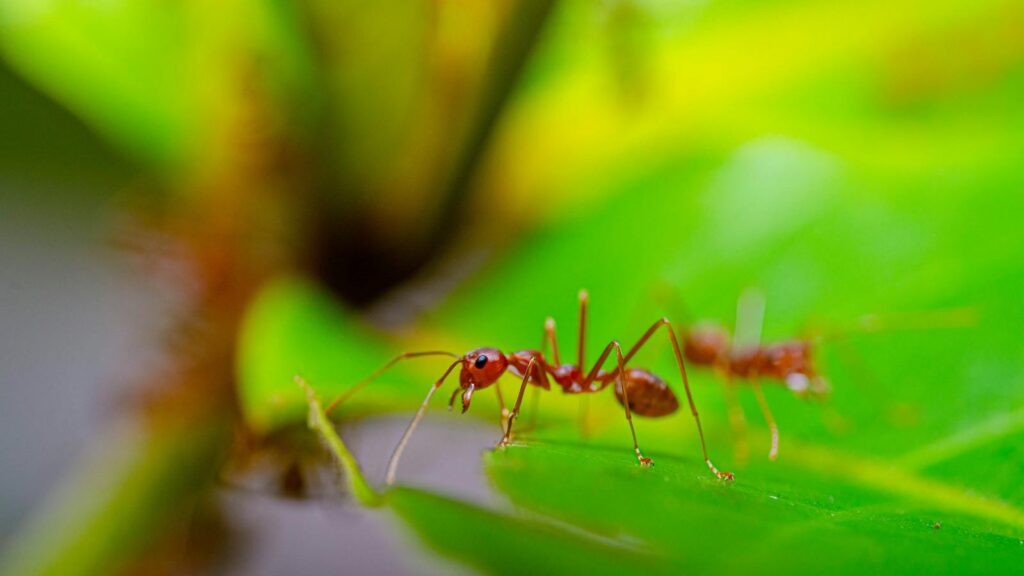Deep within the world’s tropical forests, one of nature’s most extraordinary phenomena unfolds with clockwork precision. Massive colonies of army ants surge across the forest floor in organized swarms that can number in the millions, consuming nearly everything in their path. These living rivers of coordinated hunters represent one of Earth’s most successful evolutionary strategies—a perfect storm of collective behavior that transforms individual insects into a formidable super-organism. As they march forward in pulsing columns that can stretch hundreds of feet, they create waves of panic among forest creatures, earning them the ominous nickname “rivers of death.” Yet behind this fearsome reputation lies a complex and fascinating ecological story of survival, cooperation, and evolutionary marvel that has been perfected over millions of years.
The Army Ant Phenomenon: Evolution of Nature’s Living Armies
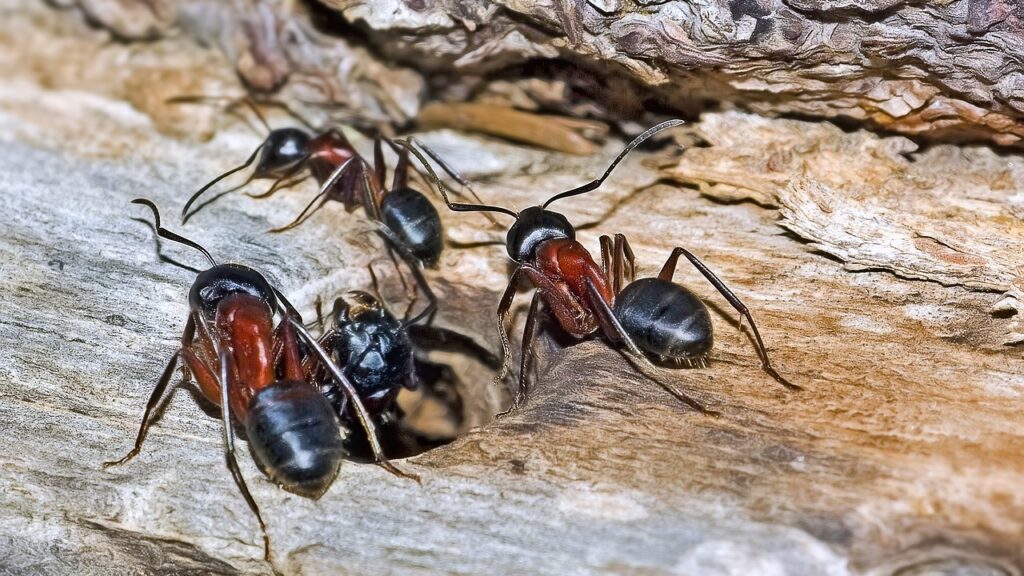
Army ants represent over 200 species across several genera, with the most famous being the Eciton burchellii of Central and South America’s rainforests. These ants evolved their nomadic lifestyle and group predation tactics independently in different parts of the world through convergent evolution, demonstrating how effective this strategy is for survival. Unlike most ant species that maintain permanent nests, true army ants are completely nomadic, alternating between stationary phases (when the queen lays eggs) and marching phases (when the colony hunts). Their bodies have specialized adaptations for their mobile lifestyle, including powerful mandibles designed for ripping prey apart and hook-shaped claws that allow workers to link together, forming living bridges and bivouacs. The evolution of army ants dates back approximately 100 million years, creating one of the most refined collective hunting systems in the animal kingdom.
The Massive Scale of Army Ant Colonies
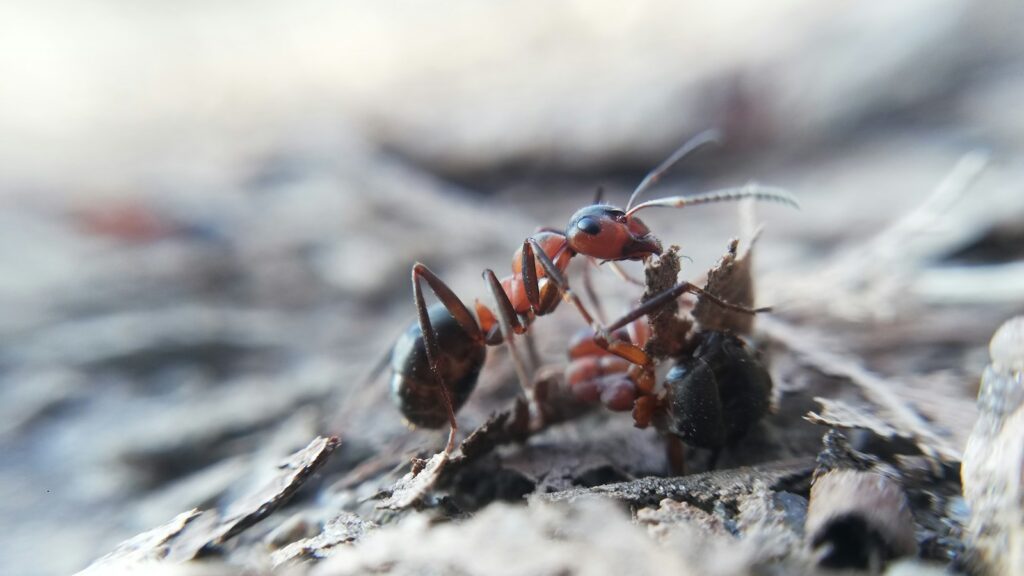
The sheer size of army ant colonies defies comprehension, with a single colony potentially containing up to 20 million individuals—a population larger than many major cities. Eciton burchellii colonies typically maintain between 300,000 to 700,000 workers, all offspring of a single queen who can lay up to 300,000 eggs during each stationary phase. The foraging columns these ants form can stretch 100 feet (30 meters) in length and 65 feet (20 meters) in width, covering up to 1,800 square feet of forest floor as they advance at a rate of approximately 65 feet per hour. During a single day’s raid, a mature colony can consume up to 500,000 prey items, representing about 100 grams of biomass—equivalent to the weight of a small bird. This collective mass of organized hunters can easily overwhelm prey hundreds of times larger than an individual ant through sheer numbers and coordinated attack strategies.
The Remarkable Cycle of Nomadic Life
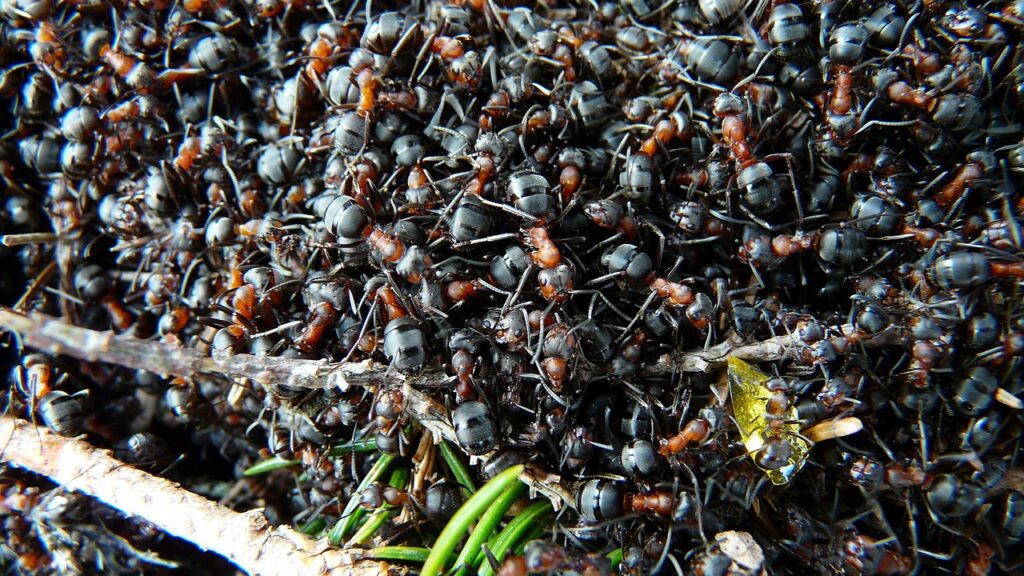
Army ant colonies follow a predictable cycle of movement dictated by the reproductive needs of their colony. This cycle typically consists of the stationary (or bivouac) phase lasting approximately three weeks, followed by the nomadic phase lasting about two weeks. During the stationary phase, the colony forms a living nest called a bivouac, constructed entirely from the bodies of worker ants who link their legs and mandibles together to create protective chambers for the queen, eggs, and developing larvae. When the eggs hatch into larvae that require substantial food, the colony transitions to the nomadic phase, conducting daily raids and relocating the entire bivouac each night to new hunting grounds. This remarkable cycle continues throughout the year without interruption, meaning the colony can travel several miles annually through the forest in search of prey, essentially functioning as a mobile ecosystem rather than a fixed colony.
Bivouacs: Living Architecture Made of Bodies
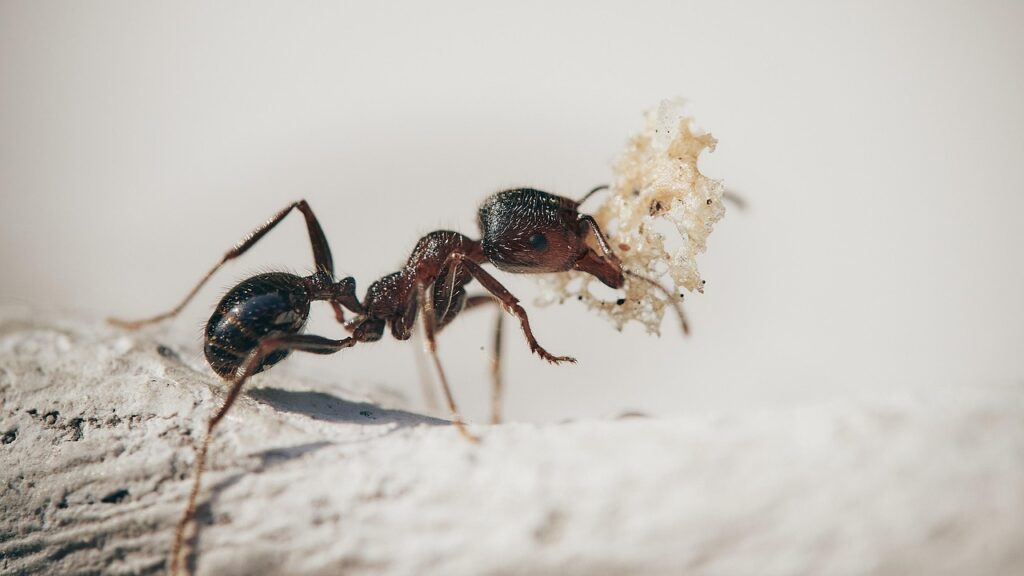
Perhaps one of the most extraordinary aspects of army ant behavior is their creation of temporary nests called bivouacs, constructed entirely from the living bodies of worker ants. Workers interlock their legs and mandibles to form a complex, layered structure that can be up to one meter in diameter, containing specialized chambers for different colony functions. The outer layer consists of larger soldier ants whose bodies form a protective barrier, while inner chambers house the queen, eggs, and developing larvae in carefully maintained microclimates. These living structures can form rapidly, with thousands of ants assembling into position within an hour, and can disassemble just as quickly when it’s time to move. Inside the bivouac, temperature and humidity are actively regulated by worker ants that adjust their positions to increase or decrease ventilation, maintaining optimal conditions for brood development regardless of external weather conditions. This remarkable feat of biological engineering allows army ants to establish protected colonies anywhere in their environment without needing to construct physical nests.
The Deadly Raid: How Army Ants Hunt

The hunting strategy of army ants represents one of nature’s most effective collective behaviors, operating with military-like precision that gives them their name. Raids begin at dawn with scout ants leaving the bivouac to identify prey-rich areas, laying chemical trails that the main colony follows in a fan-shaped formation up to 20 meters wide. This advancing front, comprised primarily of the larger submajor and major worker castes with powerful mandibles, overwhelms any creature unable to flee quickly enough. The prey is rapidly subdued through coordinated attacks where dozens of ants simultaneously bite and sting, injecting paralyzing venom. Behind this front line, medium-sized workers dismember larger prey into transportable pieces, while smaller workers capture fleeing smaller creatures and manage the traffic flow of ants returning with food to the bivouac. This systematic approach allows the colony to efficiently harvest nearly all animal life in their path, from insects and spiders to occasionally larger vertebrates like lizards, snakes, and even nesting birds.
The Queen: The Heart of the Colony
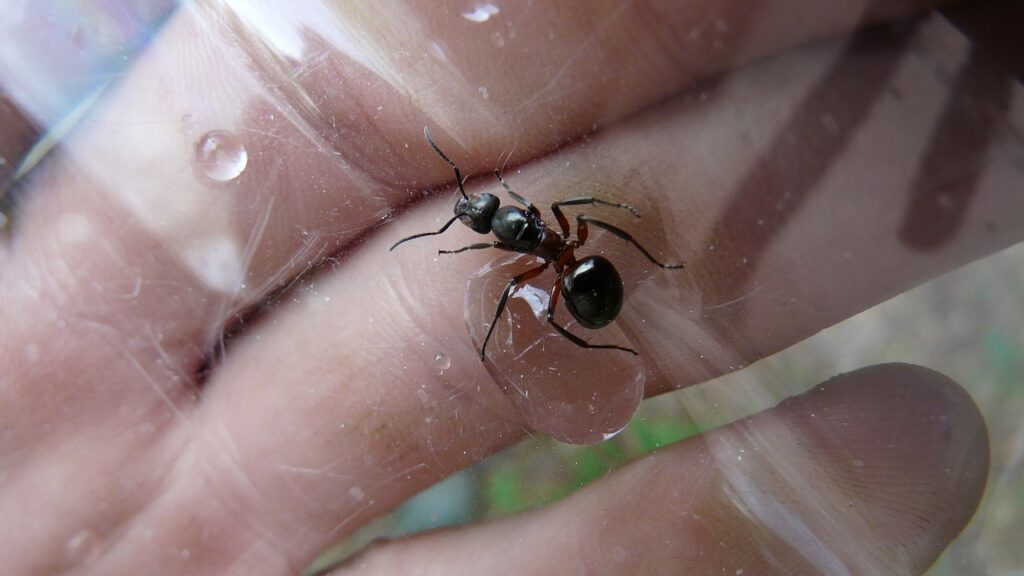
At the center of every army ant colony is a single queen, a remarkable individual whose physiology differs dramatically from her offspring. The army ant queen can be more than 20 times larger than her worker daughters, with an abdomen enormously distended to accommodate her egg-producing capabilities. Unlike queens of other ant species who establish new colonies independently, army ant queens can never survive alone—they inherit their mother’s colony in a process called colony fission, where the original colony splits when a new queen develops. During her lifetime, which can span up to 20 years, she will produce millions of offspring while being constantly attended by a retinue of workers who feed, clean, and protect her. The queen’s enormous egg-laying capacity drives the colony’s nomadic lifestyle, as her periodic production of up to 300,000 eggs creates waves of hungry larvae that must be fed through aggressive raiding. Without her, the colony would collapse within weeks, making her protection the highest priority during colony movement.
Specialized Workers: The Division of Labor

Army ant colonies feature remarkable specialization among workers, with at least four distinct castes performing specific roles essential to colony survival. The smallest workers (minors) focus on brood care, food processing, and maintaining chemical communication networks throughout the colony. Medium-sized workers form the majority of the raiding parties, capturing smaller prey and maintaining the trail networks. Submajor workers have larger heads and stronger mandibles for dismembering prey and defending against threats, while the largest soldiers have massive heads with powerful mandibles specifically evolved for defense and attacking larger prey. Unlike many other ant species where workers may shift between roles as they age, army ants are born into their specialized caste and retain those specific duties throughout their relatively short 3-6 month lifespan. This fixed specialization allows for exceptional efficiency but also requires precise coordination between castes, achieved through a sophisticated chemical communication system that maintains colony cohesion despite constant movement through changing environments.
Chemical Communication: The Invisible Command System

The coordinated movement of millions of army ants relies on an intricate system of chemical signals that serve as the colony’s primary communication network. Workers possess specialized glands that produce pheromones—chemical messages that can convey specific information to other colony members. Trail pheromones laid by scout ants guide the main colony toward prey-rich areas, with the concentration of these chemicals indicating both direction and the quality of the food source ahead. Alarm pheromones trigger rapid defensive responses when threats are detected, while recognition pheromones help ants identify colony members versus intruders. The queen produces unique royal pheromones that maintain colony cohesion and regulate worker behavior based on the colony’s current needs. This chemical language is so sophisticated that it can communicate complex messages about terrain challenges, directing workers to form living bridges across gaps or build protective structures where needed, essentially allowing the colony to respond intelligently to environmental challenges without any centralized decision-making process.
Living Bridges and Highways: Collective Engineering

Army ants demonstrate remarkable cooperative engineering through their construction of living infrastructure that facilitates colony movement. When encountering gaps in their path, worker ants link their bodies together using their claws and mandibles to form bridges that can span considerable distances, creating pathways for their nestmates carrying prey. These bridges aren’t static structures but dynamic systems that continuously optimize their position and strength based on traffic flow, with ants joining or leaving the structure as needed. Similarly, when traversing difficult terrain like steep slopes, ants will create “highways” by linking their bodies to form a stable platform that prevents other workers from slipping while carrying heavy loads. Perhaps most impressively, these structures form and dismantle without any central coordination, driven instead by simple rules followed by individual ants responding to local conditions. This self-organizing behavior allows the colony to overcome environmental obstacles that would be insurmountable to individual insects, demonstrating how collective intelligence emerges from relatively simple components working together.
The Ecosystem of Followers: Army Ant Associates

Army ant colonies don’t march alone through the forest—they form the center of a complex ecological community of “camp followers” that have evolved to exploit the hunting efficiency of these insect predators. Over 300 species are known to associate with army ant colonies, ranging from birds to insects and even mites that live exclusively on the ants themselves. Antbirds are perhaps the most famous followers, with some species like the Spotted Antbird completely dependent on army ants to flush prey from hiding places; these birds have evolved specialized behaviors to track and follow raiding columns. Numerous beetle species have developed remarkable chemical mimicry that tricks ants into accepting them as colony members, allowing these imposters to steal food or prey on ant larvae. Parasitic flies hover above columns to lay eggs on prey being carried by ants, while various butterfly species feed on the nutrient-rich droppings of antbirds following the raids. This entire mobile ecosystem represents one of nature’s most complex examples of commensalism and parasitism, demonstrating how a keystone species can support entire food webs through its activities.
Colony Reproduction: The Remarkable Process of Fission

Unlike most ant species where new queens fly away to start colonies, army ants reproduce through a fascinating process called colony fission. When a colony reaches a certain size, the queen begins producing reproductive females (future queens) and males, initiating a complex sequence of events that will split the colony. When these reproductive ants mature, the males leave the colony to find mates from other colonies, while the virgin queen remains with her mother. The colony then divides roughly in half, with workers separating into two groups—one following the old queen and the other following the new queen, who has mated with males from another colony. This reproductive strategy ensures that new queens begin their reign with an established workforce of thousands of workers, greatly improving survival chances compared to starting alone. Colony fission typically occurs once or twice annually and explains why army ant species tend to exist in related population clusters within forests, as new colonies can only establish within the traveling distance of the parent colony.
Global Diversity: Army Ants Around the World

While the Neotropical army ants of Central and South America may be the most famous, army ants have evolved independently on multiple continents, creating diverse lineages with fascinating adaptations to local environments. African driver ants (Dorylus species) form even larger colonies than their American counterparts, with some supercolonies estimated to contain over 50 million individuals, earning them the local name “siafu.” In Southeast Asia, species like Aenictus develop specialized hunting techniques for targeting termite colonies, while Australian species have adapted to the continent’s arid conditions with modified raiding patterns. Though sharing the core characteristics of nomadic lifestyle and group predation, these different lineages have evolved unique adaptations: African driver ants have more distinct worker castes and can form wider raiding fronts, while Asian army ants often specialize in hunting specific prey types rather than adopting the generalist approach of Neotropical species. This worldwide distribution and independent evolution of the army ant lifestyle demonstrates how powerful this ecological strategy is across different environments.
The Ecological Impact: Keystone Predators of the Forest
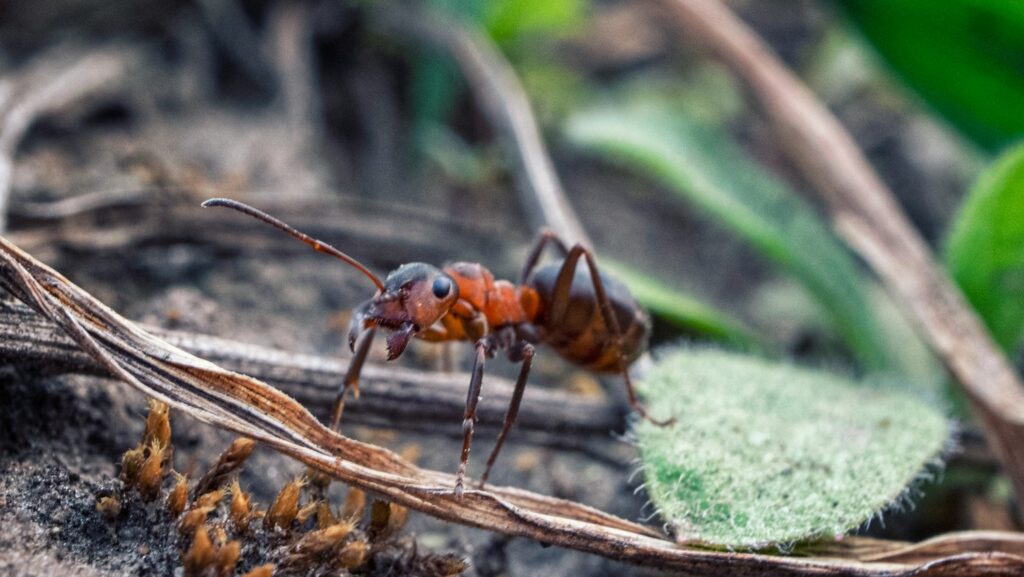
Army ants function as keystone predators within tropical ecosystems, exerting disproportionate influence on forest ecology despite their small individual size. A single colony can consume over 500,000 prey animals daily, primarily targeting social insects like wasps, bees, and other ants, along with various arthropods that typically escape predation from larger animals. Research indicates that army ants can consume up to 3,000 kilograms of prey per square kilometer annually in tropical forests, helping regulate populations of potential pest species. Their continuous movement creates a dynamic pattern of predation pressure across the landscape, preventing any single prey species from dominating local ecosystems. Additionally, their soil disturbance activities during raids enhance nutrient cycling and seed dispersal in forest floors. The presence of army ants also supports biodiversity through the complex community of follower species they attract, creating resource opportunities for dozens of bird species and hundreds of invertebrates that would otherwise lack sustainable food sources.
Threats and Conservation: The Future of Nature’s Armies

Despite their fearsome reputation, army ant populations face significant threats from human activities, particularly habitat destruction through deforestation and climate change. These ants require large, continuous areas of forest to maintain their nomadic lifestyle and access sufficient prey resources, making them particularly vulnerable to forest fragmentation. Research has shown that army ant colonies often cannot survive in forest fragments smaller than 100 hectares, as their raiding patterns require substantial territory. Climate change poses additional challenges, as the precise temperature and humidity conditions that army ants require for successful brood development are being disrupted by increasingly extreme weather patterns. Conservation efforts focusing on preserving large, intact forest corridors are essential for maintaining viable army ant populations, which in turn support hundreds of dependent species in tropical ecosystems. As scientists continue to document the complex ecological relationships centered around army ants, their value as umbrella species for conservation planning becomes increasingly apparent—protecting these remarkable insects effectively shields entire ecological communities dependent on their presence.
Army ants represent one of nature’s most spectacular examples of collective behavior transforming individual organisms into a formidable super-organism. Their continuous movement through tropical forests creates ripples through entire ecosystems, supporting hundreds of species while regulating populations of countless others. Though often feared for their predatory efficiency, these remarkable insects demonstrate the power of cooperation and specialization at a scale few other animals can match. As deforestation and climate change threaten tropical ecosystems worldwide, the preservation of these living rivers—with their complex societies and ecological relationships—becomes increasingly important. In their constant forward march, army ants not only reveal evolutionary ingenuity but also remind us how the success of nature’s most impressive phenomena often depends on the perfect balance between individual contribution and collective action.

